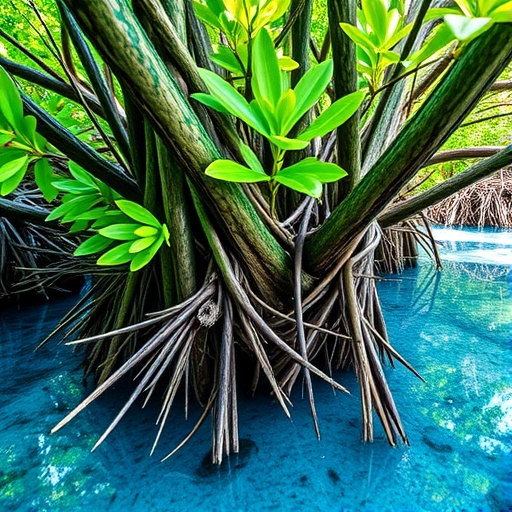Researchers have made significant strides in understanding the intricacies of soil blue carbon, particularly within mangrove ecosystems. A recent study led by Arnaud et al. has unveiled that the nature of soil blue carbon varies significantly based on the geomorphic settings of mangroves. This uncovering paves the way for more precise conservation strategies as well as carbon management initiatives critical for combating climate change. Soil blue carbon, essentially the organic carbon stored in coastal and marine ecosystems, has been recognized for its potency in sequestering carbon dioxide from the atmosphere.
Mangroves, characterized by their unique salt-tolerant trees, form important coastal ecosystems that serve as vital carbon sinks. Their muddy and anoxic conditions, combined with the intricate root systems of the mangrove trees, make these environments ideal for carbon storage. The study spearheaded by Arnaud and his colleagues has illuminated the fact that not all mangrove areas store blue carbon in the same way. Their findings show a striking variability linked to geomorphic settings, which refers to the Earth’s surface forms and the processes that create them.
As the research progressed, the team examined different types of mangrove geomorphic settings including riverine, deltaic, and fringing mangroves. Each of these settings demonstrated distinct characteristics that influence how soil blue carbon is sequestered and stored. For instance, deltaic mangroves, which thrive in sediment-rich and dynamic environments, are positioned differently in their carbon sequestration capacity when compared to riverine systems that experience more stable conditions. This revelation is critical, as the variability in carbon storage potential can inform future restoration and conservation efforts.
The study’s methodology involved extensive field sampling and analysis of soil cores from various mangrove settings across different geographic locales. To better understand carbon dynamics, researchers also deployed advanced analytical techniques to assess organic matter, nutrient content, and microbial activities across the sampled soils. These factors directly influence carbon retention and decomposition rates, thus providing a comprehensive view of how blue carbon is generated and maintained in these ecosystems.
One of the profound aspects of this research is how it addresses the often-overlooked role of sediment deposition in blue carbon dynamics. Sediments carry with them organic matter, which is crucial for carbon storage. In deltaic mangroves where sedimentation is more pronounced, the capacity for carbon accumulation tends to be significantly higher. On the other hand, in riverine settings, sediment supply can be limited, making it a less effective carbon sink. This reinforces the need for targeted strategies tailored to the specific environmental contexts of mangrove habitats.
The implications of understanding soil blue carbon variability are monumental for climate change mitigation strategies. As nations strive to meet their carbon reduction targets, improving the management of blue carbon ecosystems becomes critical. Proper management protocols based on the geomorphic settings of mangroves can enhance their function as carbon sinks. By prioritizing the preservation of the most effective blue carbon systems, governments and organizations can maximize their efforts in combating climate change.
The findings outlined by Arnaud and the research team will undoubtedly serve as a fundamental resource for conservationists, policy-makers, and researchers alike. By highlighting the distinct blue carbon characteristics across various mangrove ecosystems, this work advocates for more nuanced approaches in both conservation efforts and carbon accounting methodologies. Furthermore, it underscores the reality that conserving mangroves is just one piece of the larger puzzle in global climate action.
Moreover, this study dovetails with the growing recognition that blue carbon ecosystems are vital not only for their carbon storage capacities but also for their biodiversity. Mangrove habitats support a myriad of wildlife, from crustaceans to birds, underscoring their ecological significance. Researchers have noted that healthy mangrove systems enhance local fisheries and resilience against coastal erosion, thus creating multiple co-benefits that reinforce their importance beyond just being carbon sinks.
Future research is expected to build on these insights, probing deeper into how climate change might affect sediment dynamics and, consequently, blue carbon sequestration in mangroves. As global sea levels rise and weather patterns shift, understanding these interactions will be crucial to protect these precious ecosystems. The ongoing study of these dynamics aims to further enhance the knowledge pool surrounding coastal carbon storage and its longevity against climate variables.
In conclusion, the work by Arnaud and colleagues serves as a clarion call for the scientific community to prioritize the study of geomorphic influences on blue carbon ecosystems. Their findings reaffirm that not only do these ecosystems play an essential role in carbon storage, but they also reflect the complex interplay of geological, hydrological, and biological factors. The future of climate resilience strategies lies in the detailed understanding and management of soil blue carbon across varying landscapes, and this research is a noteworthy stepping stone in that direction.
The vital knowledge gleaned from this research is poised to spawn an era of enhanced blue carbon conservation efforts. By marrying ecological understanding with empirical data, the management of mangrove ecosystems can become both effective and sustainable. As more studies emerge and collaborative efforts increase, the path toward a thriving, carbon-sustaining future becomes clearer, urging stakeholders of various spheres to unite in this pressing mission.
Subject of Research: The variability of soil blue carbon across different mangrove geomorphic settings.
Article Title: The nature of soil blue carbon varies across mangrove geomorphic settings.
Article References:
Arnaud, M., Lovelock, C.E., Maceiras, M. et al. The nature of soil blue carbon varies across mangrove geomorphic settings. Commun Earth Environ 6, 743 (2025). https://doi.org/10.1038/s43247-025-02531-7
Image Credits: AI Generated
DOI: 10.1038/s43247-025-02531-7
Keywords: Soil blue carbon, mangrove ecosystems, geomorphic settings, carbon sequestration, climate change, sediment dynamics.




